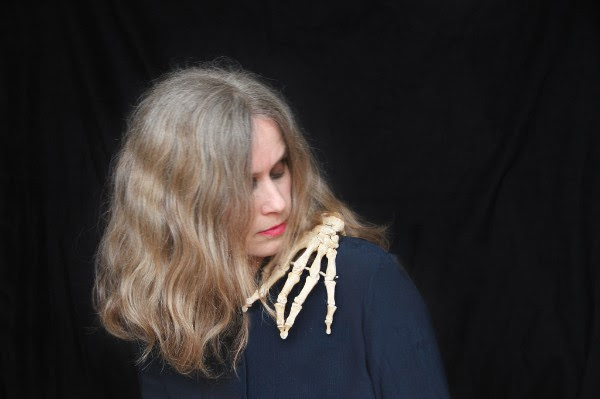Some albums spring from a specific concept — a seed of an idea that blossoms into rich branches of related notes and harmonies.
In the case of Halo, the seventh album from the prolific Argentine artist Juana Molina, there were no preconceived ideas or themes. Each of the 12 spectral compositions had a mind of their own, existing as tiny organisms that Molina conceived almost without full control. In the four years following Molina’s last album Wed 21, a collection of stubborn songs began flowing out of her at varying speeds, dictating the direction of the project. And it wasn’t until the album was complete that Molina could step back and decipher the sonic tapestry she’d made.
Halo is out now for the rest of the world to examine, and in some ways, this is a mystical effort that has rendered Molina more of a conduit than creator. Many of the songs appeared in quiet, prolonged moments Molina spent working in her Buenos Aires studio, usually after hours of fiddling around and waiting for the music to contact her like a signal from an unknown planet.

“After so much time working and trying different things, all of a sudden there’s a click and something happens. It’s like a moment where I don’t think anymore, and time disappears — as well as myself. And that’s where the truly good shows up,” Molina said in an interview with Remezcla.
“You can evolve and discover new things, and widen your range of sounds and ideas, but you will always be doing what you do.”
It could be Molina’s unusual creation process — of surrendering to the songs, of waiting until the end of the journey to understand it fully — that has resulted in an album of unprecedented character. The 54-year-old former comedian, who abandoned acting for music more than two decades ago, has always created lush soundscapes woven together by loops, echoes, and layers. On Halo, she meanders into new, dusky territory to deliver music lurking with mystery, alchemy, and a sense of the occult.
Molina’s calling card has been fearless, unbridled experimentation. On Halo, her signature warbles, bleeps, and glitches are stranger than ever, but also sharper and fuller. Part of this may have come from her time working out of Texas’s Sonic Studio with her co-producers Odwin Schwartz and Eduardo Bergallo. There, she found a playground of instruments awaiting her. Molina turned her attention to a selection of musical gadgets, toying with pedals from the 60s and 70s, a Moog Prodigy bass, and, for the first time, live drums — the latter of which burst their way onto the winding rhythms of “Cosoco,” one of Molina’s most kinetic creations yet.
She waited until most of the songs were complete before she began digging through the lyrics for a title that would string the project together. She came across “halo,” and the concept of a hovering light emerged. The idea evoked memories of “la luz mala,” an Argentine folk tale of a wafting light made of sorrow that, if followed, leads to nothing but piles of bones and human remains.
Songs such as “Lentisimo Halo” underscore these eerie, otherworldly connotations, and perhaps illustrate “la luz mala” at its most literal. Molina’s voice creeps above sparse, portentous tones, as if her vocal chords themselves have become the cryptic light coaxing errant explorers. Other tracks, such as “Paraguaya” and “Cálculos y oráculos,” continue the album’s journey through a shadowy miasma.
The lyrics, in all their evocative brilliance, almost didn’t happen. They took their time to come to Molina, and at one point, she considered making an instrumental album. But when she finally did find the words, she describes the feeling as a door flying open and a panoply of ideas tumbling out. “When you look at [the songs], they all have an atmosphere, something dark, a bit sad. There isn’t much joy in the lyrics…I think it’s subconscious and a reflection of what I was going through, which was nothing in particular — but the way I think of it was like being in a cave waiting for things to happen,” she explains.
While the lyrics on Halo flirt with spookiness, the album itself never descends fully into deep menace or terror. Take, as an example, the unnerving creature that stares at listeners on the cover of the album. Molina’s longtime creative partner Alejandro Ros created the image after taking her photo. He returned some time later with the supernatural little monster, which Molina didn’t realize was supposed to be a bone. And while the character was certainly eerie, it was never meant to be entirely scary. “It freaked me out. It was striking; it was telling you something. It was a creature that was observing you and it was a little bit threatening, but at the same time, harmless,” Molina says.

The beauty of Molina’s work remains its openness. Even when the music is imbued with dimness, it remains subjective and freewheeling. As an example, Molina had sent “Lentisimo Halo” to Mariano Ramis, a professor and filmmaker in Argentina. When he heard the song, he immediately churned out a fantastically eerie short film that recalls the work of Man Ray and Joseph Cornell. The hazy, five-minute video is a different, surreal take on Molina’s music, but an interpretation that evokes the album’s enigmatic quality, nonetheless.
In the canon of Molina’s seven albums, Halo will stand not only as the darkest, but perhaps the fullest in sound. There is a marked evolution in instrumentation from Molina’s earlier, acoustic-driven records, like Segundo and Rara. Molina, a self-described creature of habit, has reached new milestones with this release, but explains that every bit of Halo is an unmistakable piece of herself. “You can evolve and discover new things, and widen your range of sounds and ideas, but you will always be doing what you do. Yes, it’s a different star, a different planet, but it’s the same universe,” she said.
Juana Molina’s Halo is out now via Crammed Discs.







